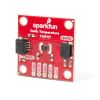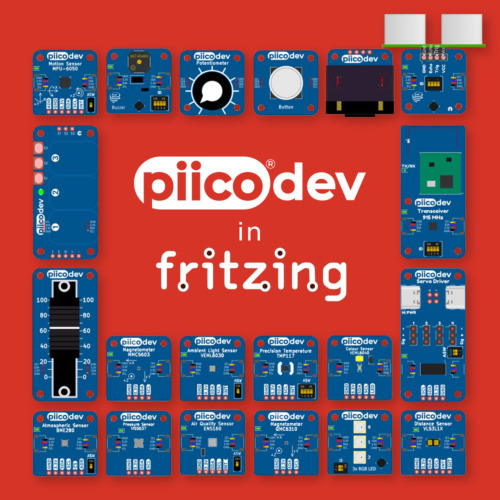SparkFun High Precision Temperature Sensor - TMP117 (Qwiic)
In stock, ships same business day if ordered before 2PM
Delivered by Tue, 2nd of Dec
Quantity Discounts:
- 5+ $26.55 (exc GST)
- 25+ $26.00 (exc GST)
- 100+ $24.90 (exc GST)
The SparkFun Qwiic TMP117 breakout is a high precision temperature sensor equipped with an I2C interface. It outputs temperature readings with high precision of ±0.1°C across the temperature range of -20°C to 50°Cs with no calibration and a maximum range from -55°C to 150°C. The SparkFun High Precision Temperature Sensor also has a very low power consumption rate which minimizes the impact of self-heating on measurement accuracy. Utilizing our handy Qwiic system, no soldering is required to connect it to the rest of your system. However, Sparkfun still have broken out 0.1"-spaced pins in case you prefer to use a breadboard.
The SparkFun High Precision Temperature Sensor also includes programmable temperature limits, and digital offset for system correction. While the TMP102 is capable of reading temperatures to a resolution of 0.0625°C and is accurate up to 0.5°C, the on-board TMP117 is not only more precise but has a 16-bit resolution of 0.0078°C!
To make this breakout even easier to use, we've written an Arduino library to help you get started "Qwiic-ly." Check the Documents tab above for more information.
The SparkFun Qwiic Connect System is an ecosystem of I2C sensors, actuators, shields and cables that make prototyping faster and less prone to error. All Qwiic-enabled boards use a common 1mm pitch, 4-pin JST connector. This reduces the amount of required PCB space, and polarized connections mean you can't hook it up wrong.
Get Started with the SparkFun High Precision TMP117 Hookup GuideFeatures
- Uses I2C interface (Qwiic-enabled)
- Four selectable addresses
- 0x48 (default), 0x49, 0x4A, 0x4B
- 16-bit resolution, 0.0078°C
- High accuracy, digital temperature sensor
- ±0.1°C (max) from –20°C to 50°C
- ±0.15°C (max) from –40°C to 70°C
- ±0.2°C (max) from –40°C to 100°C
- ±0.25°C (max) from –55°C to 125°C
- ±0.3°C (max) from –55°C to 150°C
- Operating temperature range
- -55°C to 150°C
- Operating voltage range
- 1.8V to 5.5V
- Typically 3.3V if using the Qwiic cable
- Low power consumption
- 3.5µA (1-Hz conversion cycle)
- 150nA (shutdown current)
- Programmable operating modes
- Continuous, one-shot, and shutdown
- Programmable temperature alert limits
- Selectable averaging for reduced noise
- Digital offset for system correction
- NIST traceability
Documents
Exact shipping can be calculated on the view cart page (no login required).
Products that weigh more than 0.5 KG may cost more than what's shown (for example, test equipment, machines, >500mL liquids, etc).
We deliver Australia-wide with these options (depends on the final destination - you can get a quote on the view cart page):
- $3+ for Stamped Mail (typically 10+ business days, not tracked, only available on selected small items)
- $7+ for Standard Post (typically 6+ business days, tracked)
- $11+ for Express Post (typically 2+ business days, tracked)
- Pickup - Free! Only available to customers who live in the Newcastle region (must order online and only pickup after we email to notify you the order is ready). Orders placed after 2PM may not be ready until the following business day.
Non-metro addresses in WA, NT, SA & TAS can take 2+ days in addition to the above information.
Some batteries (such as LiPo) can't be shipped by Air. During checkout, Express Post and International Methods will not be an option if you have that type of battery in your shopping cart.
International Orders - the following rates are for New Zealand and will vary for other countries:
- $12+ for Pack and Track (3+ days, tracked)
- $16+ for Express International (2-5 days, tracked)
If you order lots of gear, the postage amount will increase based on the weight of your order.
Our physical address (here's a PDF which includes other key business details):
40 Aruma Place
Cardiff
NSW, 2285
Australia
Take a look at our customer service page if you have other questions such as "do we do purchase orders" (yes!) or "are prices GST inclusive" (yes they are!). We're here to help - get in touch with us to talk shop.
Have a product question? We're here to help!
Guides
The Maker Revolution
Projects
PiicoDev Ecosystem In Fritzing
10" Home Lab Testing Rack
WLED Hourglass Theatre Prop - DMX Over Wi-Fi!
Makers love reviews as much as you do, please follow this link to review the products you have purchased.


















Product Comments